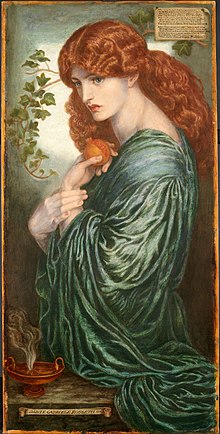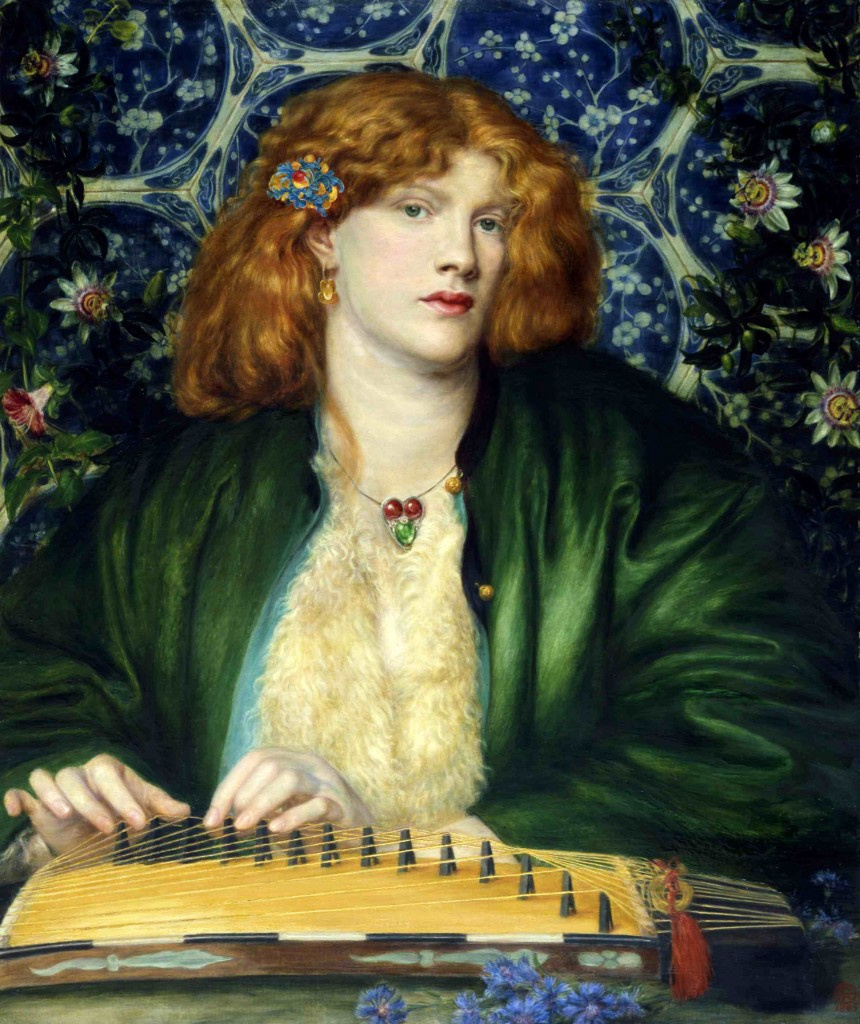 |
| One of many self-portraits |
The blessed damozel leaned out
From the gold bar of Heaven;
Her eyes were deeper than the depth
Of waters stilled at even;
She had three lilies in her hand,
And the stars in her hair were seven.
~ Dante Gabriel Rossetti ("The Blessed Damozel," st. 1)
If you paint as well as you write you may be a rich man, or at all events, if you do not wish to be rich, may get leisure enough to cultivate your writing. But I need hardly tell you that poetry, even the best... is not a thing for a man to live upon while he is in the flesh, however immortal it may render him in spirit.
~ Leigh Hunt (1784-1859) (letter to Rossetti, March 1848)
He produced several versions of Proserpine (wiki) (sometimes Proserpina), the Roman goddess who lives in the underworld during Winter, using Jane Morris* (wife of his friend and fellow pre-Raphaelite William Morris) as model. On the top right his sonnet, in Italian, is inscribed by the artist - the same sonnet in English is inscribed on the frame (see below).
 |
| The final of several iterations of Proserpine, the Roman goddess who lives in the underworld during Winter, with Jane Morris as model. |
Per Rossetti, on Perserpine:
"She is represented in a gloomy corridor of her palace, with the fatal fruit in her hand. As she passes, a gleam strikes on the wall behind her from some inlet suddenly opened, and admitting for a moment the sight of the upper world; and she glances furtively towards it, immersed in thought."
The sonnet:
Afar away the light that brings cold cheer
Unto this wall, – one instant and no more
Admitted at my distant palace-door
Afar the flowers of Enna from this drear
Dire fruit, which, tasted once, must thrall me here.
Afar those skies from this Tartarean grey
That chills me: and afar how far away,
The nights that shall become the days that were.
Afar from mine own self I seem, and wing
Strange ways in thought, and listen for a sign:
And still some heart unto some soul doth pine,
(Whose sounds mine inner sense in fain to bring,
Continually together murmuring) —
'Woe me for thee, unhappy Proserpine'.
~ D. G. Rossetti
* Rossetti stayed with his lover Jane Morris, wife of William Morris, at Kelmscott Manor during the summer months each year - in winter she returned to stay with William Morris, thus paralleling, at least from Rosetti's point of view, Proserpine's freedom during summer.
 |
| Blue Gazebo - larger version here. Note the medieval millefleur ("thousand flowers") style background - characteristic of the pre- Raphaelites in general, although less so of Rossetti in particular. |
May 12 is the anniversary of the birth of English poet and pre-Raphaelite painter Dante Gabriel Rossetti (wiki) (1828-1882). Born in London, Rossetti founded the "Pre-Raphaelite Brotherhood" (wiki) in 1848 with Holman Hunt, John Millais, and others to protest low standards in British art - the Pre-Raphaelite movement sought to revitalize British art by returning to the spiritual qualities of medieval painting, with an emphasis on detailed observation of the natural world and the use of pictorial narrative to convey "truth". Some of his best paintings were done under the patronage of John Ruskin and the influence of William Morris and Edward Burne-Jones, all of whom Rossetti befriended early in his life.
In both his paintings and his poetry (such as "The Blessed Damozel"), Rossetti presented idealized portrayals of womanhood. He was also a prolific translator of early Italian verse from Dante's circle - leading Ruskin to describe him as "a great Italian lost in the inferno of London."
Here's an archive of his art works and one of his poetry.
I'm a huge fan of pre-Raphaelite art, and, back in the 70s when I was into fantasy, I read everything William Morris ever wrote. About them as a group, though, and their weird interactions - I've run into a little bit as part of other articles, but every time I run into more I realize, once again, how weird they were. Here's a bit on insight into that:
On Dante Gabriel Rossetti and wombats. (London Review of Books) (There is a book on this, by the way: Rossetti's Wombat: Pre-Raphaelites and Australian Animals in Victorian London, in case you're interested. I'm not that interested.): an excerpt from the article is is below, but read the whole thing.
Rossetti's sister, Christina Rossetti (wiki) (1830-1894), who lived much of her life as a virtual recluse, is also remembered as a major Victorian lyric poet. Here's one of the illustrations he did for her poem "The Goblin Market" (wiki) (full poem online) - note all of the wombats:
He had two, one named Top after William Morris, whose nickname ‘Topsy’ came from his head of tight curls. In September 1869, Rossetti wrote in a letter that the wombat had successfully interrupted a seemingly uninterruptable monologue by John Ruskin by burrowing its nose between the critic’s waistcoat and jacket. Rossetti drew the wombats repeatedly; he sketched his mistress – William Morris’s wife, Jane – walking one on a leash. In the image, both Jane and the wombat look irate. Both wear halos.
Lots more on the subject here: “O Uommibatto”: How the Pre-Raphaelites Became Obsessed with the Wombat.
Parts of the text above are adapted from Ed's Quotation of the Day, only available via email - leave your email address in the comments if you'd like to be added to his list. Ed is the author of Hunters and Killers: Volume 1: Anti-Submarine Warfare from 1776 to 1943 and Hunters and Killers: Volume 2: Anti-Submarine Warfare from 1943.


No comments:
Post a Comment